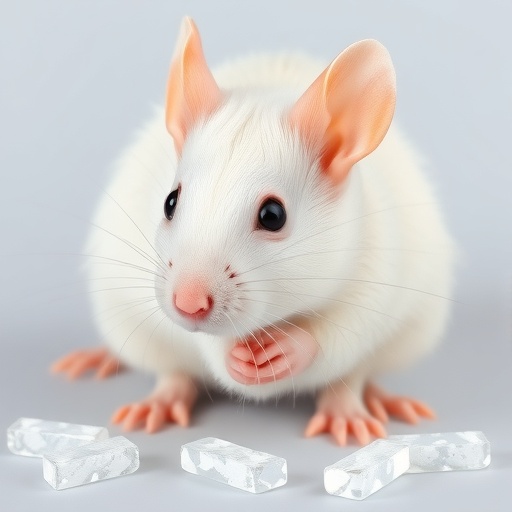
In a groundbreaking study that challenges long-held perceptions about artificial sweetenersâ effects on physiological processes, researchers have uncovered critical insights into how gestational consumption of saccharin can significantly disrupt the gut-brain axis, particularly in the context of glucose homeostasis. The implications are profound, possibly reshaping dietary guidelines for expectant mothers and raising crucial questions about the long-term health of their offspring. This exploration into the intricate dance of nutrition, metabolism, and neural signaling lays bare the complexities of maternal diet and fetal development.
Gestational exposure to artificial sweeteners such as saccharin, a common sweetening additive, has been under the microscope in recent years. While saccharin has long been approved for use, its impacts on metabolic pathways remain contentious. The study conducted by Pacheco-Sánchez and colleagues offers fresh perspectives by investigating how saccharin alters the delicate balance of glucose regulation in rats. This focus on the gut-brain axis is particularly timely, as the increasing consumption of artificial sweeteners in Western diets raises concerns about potential long-term health ramifications.
The researchers specifically assessed the effects on adolescent offspring rats that had been gestationally exposed to saccharin. This model allows for a closer examination of developmental impacts, particularly through critical windows in gestation and postnatal growth. Notably, the study found that the disruptions in glucose homeostasis were distinctly sex-dependent, indicating that male and female offspring responded differently to their mothersâ saccharin consumption. This finding suggests that hormonal and genetic factors may play a substantial role in how artificial sweeteners affect metabolic health across genders.
The gut-brain axis integrates signals from the gastrointestinal tract with neural circuitry in the brain, fundamentally influencing appetite, metabolism, and energy balance. Saccharinâs interference in this communication network raises essential questions about the underlying mechanisms at play. The researchers utilized advanced techniques to trace glucose metabolism and hormonal responses during various developmental stages. This allowed them to elucidate how saccharin may skew normal metabolic signaling, particularly in relation to insulin sensitivity and appetite regulation.
In addition to hormonal influences, the study also highlighted alterations in the microbiome as a potential pathway through which saccharin exhibits its effects. The gut microbiome has garnered significant attention as a regulator of health, influencing everything from digestion to mental health. By disrupting microbial communities during critical periods of development, saccharin could instigate changes that favor obesity and metabolic syndrome in later life. The implications of this are especially concerning for populations that may already be genetically predisposed to metabolic disorders.
Given that saccharin is a non-nutritive sweetener, it is often perceived as a calorie-free alternative to sugar, allowing consumersâespecially expectant mothersâto indulge their cravings without the caloric baggage. However, this latest research urges a reassessment of these assumptions. The findings underscore the necessity for clearer guidelines surrounding the consumption of artificial sweeteners during pregnancy. Pregnant individuals may unknowingly expose their developing children to substances that could predispose them to metabolic dysfunction, thus perpetuating cycles of health issues.
The researchers adopted a rigorous methodological framework, employing both behavioral assessments and biochemical analyses to capture a comprehensive picture of saccharinâs effects. This multi-faceted approach revealed fluctuations in glucose levels and insulin secretion, linking dietary intake directly to metabolic outcomes down the road. By identifying such disruptions early in life, the study serves as a clarion call for future research into preventative measures that could mitigate these risks.
Equally important is the exploration of potential mitigative strategies that could be implemented post-exposure. While the study highlights serious risks associated with in utero saccharin consumption, it also opens avenues for investigating dietary interventions or probiotics that could restore balance to the gut-brain axis and promote healthy metabolic function. This suggests a dual focus for future research: understanding the pathways through which adverse effects occur, and identifying ways to counteract them.
Moreover, the sex-dependent findings introduce additional layers of complexity, suggesting that tailored health interventions may be essential. Personalizing dietary guidance based on sex and genetic predisposition could enhance the effectiveness of public health recommendations. As we move forward, acknowledging the intricate interplay of diet, biology, and health outcomes is paramount.
As artificial sweetener consumption continues to be a common choice for many, the evidence provided by this study serves as a reminder of the unpredictable ways such interventions can affect health. Creating awareness around these potential risks is essential, as it empowers individuals to make informed choices about their diets and health.
In conclusion, the findings of Pacheco-Sánchez et al. should not be interpreted as an outright condemnation of artificial sweeteners. Rather, they invite a thoughtful discussion about nutritional choices and their consequences. A deeper understanding of how dietary components during pregnancy influence the developmental trajectory of offspring is critical as we seek to promote healthier future generations. This study solidifies the need for continued investigation into the long-term effects of gestational diets and the lasting imprint they leave on offspring health.
In the pursuit of safeguarding future generations’ health, these findings accentuate the necessity of balancing cravings, health beliefs, and scientific evidence. As consumers, healthcare providers, and policymakers grapple with the implications of artificial sweeteners, ongoing dialogue informed by research will be crucial in charting a path toward optimized maternal and pediatric health.
The study’s insights pave the way for further inquiries into various artificial sweeteners and their metabolic impacts. Each discovery adds to a growing tapestry of knowledge that underscores the significance of maternal health in shaping offspring outcomes, revealing that every choice made during pregnancy can have far-reaching consequences for the next generation.
The world of nutrition is complex, where the intersection of science and behavior is constantly evolving. Emphasizing the need for evidence-based practices could significantly enhance our collective approach to dietary guidance, ensuring that emerging data informs our understanding of the ever-shifting landscapes of health and wellness.
Ultimately, as research continues to illuminate the potential ramifications of dietary choices on health, the lessons learned from this study may redefine our relationship with not only artificial sweeteners but also dietary habits overall. This evolving dialogue offers hope for developing more effective public health strategies that prioritize the well-being of mothers and their children.
With increasing awareness and ongoing research, we may move toward a more nuanced understanding of how to foster well-being in families, ensuring that future generations can thrive with optimal health, free from the burdens of preventable dietary complications.
Subject of Research: Gestational consumption of saccharin and its effects on the gut-brain axis and glucose homeostasis
Article Title: Gestational saccharin consumption disrupts gut-brain axis glucose homeostasis control in adolescent offspring rats in a sex-dependent manner
Article References: Pacheco-Sánchez, B., Melgar-Locatelli, S., López-Merchán, R. et al. Gestational saccharin consumption disrupts gut-brain axis glucose homeostasis control in adolescent offspring rats in a sex-dependent manner. Biol Sex Differ 16, 43 (2025). https://doi.org/10.1186/s13293-025-00724-5
Image Credits: AI Generated
DOI: 10.1186/s13293-025-00724-5
Keywords: gestational exposure, saccharin, gut-brain axis, glucose homeostasis, adolescent health, sex-dependent effects, maternal diet, metabolic health.
Tags: adolescent rats study on saccharinartificial sweeteners and glucose homeostasisdietary guidelines for expectant mothersgestational consumption of sweetenersgestational exposure to saccharinglucose regulation in offspringimpacts of artificial sweeteners on metabolismlong-term health effects of saccharinmaternal diet and fetal developmentmetabolic pathways of artificial sweetenersnutrition and neural signalingsaccharin effects on gut-brain axis




